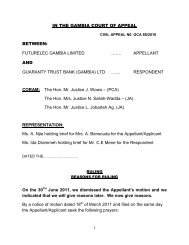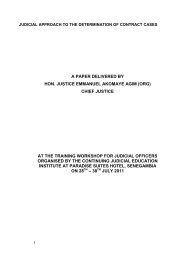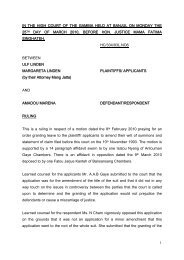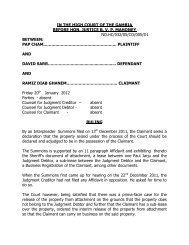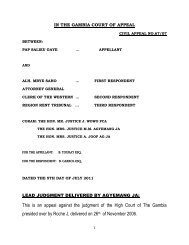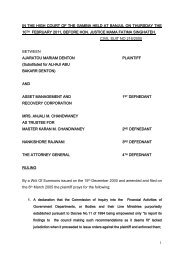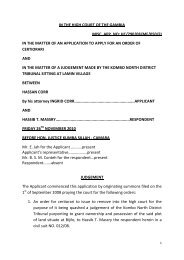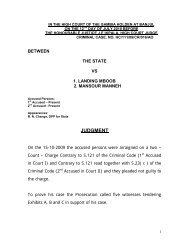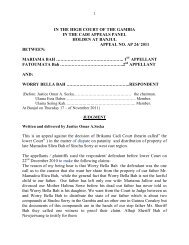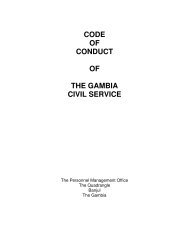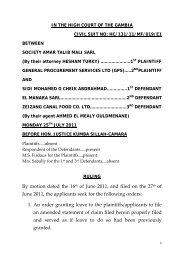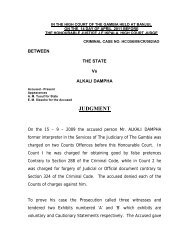You also want an ePaper? Increase the reach of your titles
YUMPU automatically turns print PDFs into web optimized ePapers that Google loves.
IN THE SUPREME COURT OF THE GAMBIASC CRIMINAL APPEAL NO. 8/2011BETWEEN:BATCH SAMBA FAYE …. …. APPELLANTANDTHE STATE …. …. …. …. RESPONDENTWednesday 17 th October 2012CORAM: Hon. Justice Emmanuel Akomaye Agim (ORG),CJHon. Justice G. Semegah – Janneh, JSCHon. Justice Jones Dotse, JSCHon. Justice Henrietta Abban, JSCHon. Justice E. K. Ayebi, JSCAppellant presentIda D. Drameh with M. A. Samba for the AppellantD. O. Kulo Director of Special Litigation for the Respondent===================================================================================================RULING:===================================================================================================HENRIETTA ABBAN, JSC:This is an interlocutory appeal from the Court of Appeal against adecision of the said court dated the 14 th day of October, 2011. Thegrounds of appeal stated in its particulars as follows:A. The Court of Appeal erred in law in striking out the appealwithout determining same on merits.Particulars:i. The Court of Appeal had no regard for the provisions ofsection 10 of the Court of Appeal of the Gambia Act.1
ii.The Court of AppealB. The Court of Appeal erred in law in failing to set aside thejudgment of the High Court when there was a clear miscarriageof justice.Particulars:i. The Court and the court system failed to protect or keep safeexhibits and files required by the appellant for theprosecution of his appeal.ii.The appellant has his appeal struck out in the Court ofAppeal even though the duty to retain and keep all exhibitsfrom the trial court was that of the court and not theappellant who was at all material times on death row.C. The Court of Appeal erred in law in failing to give effect to themandatory words of S.6(1) of the Court of Appeal of the GambiaAct (cap 6:02) of the laws of the Gambia.Particulars:i. The Court of Appeal was mandated by the said section if itconsidered that there was a miscarriage of justice to allowthe appeal.ii.There was a clear miscarriage of justice in the inability ofthe court to determine the appeal in the absence of theexhibits which were at all times in or required by law to bein the High Court’s possession or custody or ought to havebeen.2
iii. The appellant was denied his right to have his appealproperly determined or determined on the merits as a resultof the Order of the Court of Appeal.iv.The Court of Appeal could have properly determined theAppeal even in the absence of the exhibits but it failed to doso.D. The Court of Appeal had no regard for provisions of section 24 ofthe Constitution which at all times guaranteed the appellant afair hearing before an independent and impartial court.E. Having held in its ruling of the 26 th day of May, 2010 that theappellant’s appeal should be determined on the basis of therecord of appeal before the court, (which excluded all but oneexhibit), the Court of Appeal erred in law in ignoring its saidearlier decision/ruling and striking out the appeal because of theabsence of the said documents. The learned Court of Appealmisdirected itself in law and in fact by holding that the prayerof the appellant for the appeal to be allowed and the appellantacquitted and discharged was impossible to entertain.Particulars:i. The Court of Appeal had held in its ruling of the 26 th May,2010 that the appeal would be determined on the meritsbased on the Record of Appeal before the court and the soleexhibit available.ii.The Court of Appeal wrongly overruled and set aside its 26 thday of May, 2010 decision thereafter holding on the 14 th3
October, 2011 that the Record of Appeal was incomplete and“may not be used to determine the appeal.”iii.The Court of Appeal erred in law in failing to appreciatethat the appeal which led to the ruling of the 26 th May, 2010and the ruling of the Supreme Court given on the 19 th day ofNovember, 2011 were on the preliminary issue formulatedby the Court of Appeal.F. The Court of Appeal erred in law and failed in its duty toproperly evaluate the evidence that was before the High Court.Particulars:i. Not all of the witnesses and/or exhibits that had beentendered attracted equal weight and/or attention.ii. The Court of Appeal failed to determine the weight the HighCourt attached to the testimony of the witnesses called inthe High Court and if same was proper.iii. The Court of Appeal failed to determine the qualitativenature of the exhibits some and parts of which were referredto in the record before the court.iv. The court failed to find that the evidence tendered wasinsufficient to convict the appellant.v. On the basis of the learned trial Judge’s treatment of theevidence of Dr. Duanba and exhibit J. alone, he ought tohave acquitted the appellant of the offence charged.G. Having held that there was some material on the recordincluding copious references to the contents of exhibits made bythe trial Judge which could have assisted the court in coming to4
its own conclusions, the court ought properly to have used sameto come to its own conclusions on the merits of the appeal.H. The Court of Appeal erred in law and misunderstood thesubmission of the appeal.Particulars:i. The argument of the appellant with due respect to the Courtof Appeal ought not to be heard in the absence of theexhibits crucial to his case.ii.The appellant’s submission was that it would be impossibleto have a fair hearing and that therefore the court ought toallow the appeal.I. Having held that the record was incomplete and could not beused to determine the appeal, the Court of Appeal erred in lawin not acquitting and discharging the appellant.Particulars:i. The records and exhibits were at all times in the custody ofthe court.ii.There was no suggestion that all efforts to trace the missingexhibits had not been made that a complete record could becompiled.J. The right of appeal being statutory and time bound and theconviction having been on the 3 rd December, 2004, the court hadno power in October, 2011 to grant the appellant the liberty tofile a fresh appeal.5
K. Having held that the court could not close its eyes to thepossible injustice that may result if a complete record is notfurnished, the court erred in law in holding, “the instant appealpremature.”Particulars:i. The appellant had a right to have his appeal filed on the 8 thday of December, 2004 determined on its merits.ii. The appellant having been on death row from the 3 rd day ofDecember, 2004 had a reasonable expectation that hisappeal filed five days later would be determined on themerits.iii. The Order made by the Court of Appeal would have theeffect of denying the appellant an opportunity to have hisappeal determined on the merits.L. The Court of Appeal made reference and relied on several casesmostly civil from jurisdictions with rates which were notapplicable in this case.M. The deprivation by the Court (and the trial court) of anappellant’s right to prosecute his appeal and to have the appealdetermined on the merits was unconstitutional and legallywrongful.Particulars of Proceedings in Court below:i. Date of decision appealed against 14 th day of October, 2011.ii.Court from whose decision appeal is made: The Court ofAppeal of the Gambia.6
Proceedings and the exhibits which would enable the appellant file hisgrounds of argument in order to prosecute his appeal were missing.The Court of Appeal therefore Ordered both Counsel for the Defence andthe Prosecution to convince them as to whether the appeal can proceed inthe absence of the original record of proceedings and the exhibits - that isto say “what is the legal consequence of the incomplete Record ofAppeal on this appeal.” From the respective briefs, as culled from theRecord of Appeal, it was not disputed that the record of this appeal wasinitially compiled by Mr. O’Brien Coker, the Registrar of the High Courtwho had since left the jurisdiction.Also, not disputed is the fact that the same Record of Appeal wassubsequently recompiled and certified by Mrs. M. C. Mboob Ceesay whosucceeded Mr. O’ Brien Coker as Registrar of the High Court. Alsoundisputed is the fact that the exhibits enumerated in paragraph 9 of theappellant’s brief Exhibit A (broken knife), Exhibits B, B1, B2, Exhibit C,Exhibit D, Exhibits E & F, Exhibit G, Exhibit H, Exhibit I, Exhibit J,Exhibit K, Exhibit L and Exhibit M are the exhibits tendered andadmitted at the actual trial at the High Court. Unfortunately, theseexhibits apart from Exhibit G got missing before the Record of Appealcould be compiled.Also undisputed is the fact that the original Record of Proceedings beforethe High Court (i.e. the Court File) got missing before same could betransmitted to the Court of Appeal as evidenced by a letter dated 9 thNovember, 2009 reference No. 2A 246/248/01/(52) signed by the PrincipalRegistrar of the High Court. The allegation before the court is not thatthere is no Record of Appeal. No specific portion of the Record of Appeal8
has been attacked. The appellant’s grievance rests on the missingexhibits which were duly tendered by the prosecution, not objected to bythe defence and therefore form part of the prosecution’s case against theappellant. They therefore form part of the Record as far as theiradmission in evidence and subsequent analysis are concerned.The record of the missing exhibits has not been specifically attacked bythe appellant. There is nothing on record indicating that certain matterswhich were recorded during the trial of the appellant have not beenreflected in the Record of Appeal. The question as to whether theproduction of the missing exhibits are so paramount to the Appeal as toprejudice the rights of the appellant is a matter which can only come intolight in the course of the hearing of the appeal before the Court of Appealsince an appeal is by way of rehearing.However, it is trite that the rehearing is based on the Record of Appealand not on the physical production of witnesses, exhibits or documentsexcept where the Court of Appeal deems it expedient to Order otherwisesince an appeal is fought solely on the Grounds of Appeal properly raised,and the purpose of the Grounds of Appeal is to give notice to therespondent of the issues in controversy on appeal, just like pleadings aremeant to give notice to the adverse party of the facts in issue during trial,to enable the latter defend same adequately. The grounds determine thejurisdiction of the appellate court and restrict its jurisdiction to only thecomplaints raised before it in the Grounds of Appeal.In the appeal before the Court of Appeal, there is a Record of Appealbefore the court which contains the record of the trial proceedings, theoffence charged, the evidence led and the judgment of the trial court. It is9
from the judgment that the appellate court would discern and indeeddetermine what evidence charge/charges upon which the appellant wasconvicted and whether this conviction can be sustained. Presently, thereis a record which contains the charge, the evidence led and the judgmentof the trial court. These facts have not been impeached by the appellant.On the 26 th May, 2010, the Court of Appeal ruled that the appeal recordsare proper for the determination of the appeal. On the 18 th June, 2010,Counsel for the appellant sought leave of the Court of Appeal for theappellant to appeal to the Supreme Court on the grounds that theappellant’s constitutional rights had been infringed upon because all theexhibits had not been made available to him to enable him prepareadequately to prosecute his appeal. The Supreme Court also dismissed aninterlocutory appeal lodged against the said ruling before it in BalchSamba Faye Vrs. The State Criminal Appeal No. 2/2010 (asreported).The major issues raised for determination in this appeal is whether theGambia court of appeal erred in law in striking out the appeal withoutdetermining same on merits. Since no appeal has been determined by thecourt of appeal, it follows that no appeal can lie to the Supreme Court.Having held in its ruling of the 26 th May 2010 that the appeal would bedetermined on the merits on the basis of the record of appeal before it andthe sole exhibit available, the Court of Appeal wrongly ruled in settingaside its decision of 26 th May 2010.The Supreme Court in its ruling of 19 th November, 2011 held inter aliathat the Court of Appeal was to go into the merits of the Appellant’s10
grounds of appeal and make findings thereon. Instead, the Court chosethe short way out by deciding that the records are incomplete andtherefore the appeal is struck out till the missing exhibits are found andthen the Appellant is at liberty to re-appeal.We agree with counsel for the appellant on her submission that by failingto comply with the Supreme Court’s decision of 19 th November 2011, theCourt of Appeal erred in law and failed in its duty to properly evaluatethe evidence that was before the High Court. She further submitted andwe tend to agree with her that having held that there was some materialon the record including copious references to the contents of exhibits madeby the trial judge which could have assisted the Court of Appeal in comingto its own conclusions, the court ought to have properly used same tocome to its own conclusions on the merits or demerits of the appeal.Having failed to do so, we hold that no appeal has been determined by theCourt of Appeal and therefore what is currently pending before the courtsis the decision of the High Court.From the look of things the current grounds of appeal before the SupremeCourt are a repeat of what was previously placed before the SupremeCourt based on which the ruling of 11 th November 2011 was delivered.It would appear from the record of appeal that pursuant to the SupremeCourt’s direction of 19 th November, 2011, the Appellant went to the Courtof Appeal and raised the question of the loss of exhibits once more.It was based on this, that the court decided to strike out the appeal. Thepreliminary objection by the DPP that going by the principle of estoppel inpais, the party who invited the court to adopt a particular procedure11
cannot later be heard to complain about that same procedure, is the rightposition, and this court holds the same view. See the cases of OmarManjang & another vrs. The State (Gambia Criminal Appeal case DigestVol. 1 page 11 at pg. 17, paragraph 40). Kyn Kin vrs the State (GambiaCriminal Appeal Case Digest Vol. II page 1 at pg. 3, paragraph 6). Davisvrs Galmoye (1888) 39 ch. D 323 which support this view.We are also of the view that the Appellant cannot go on blowing hot andcold. Either he wants the appeal heard in spite of an incomplete record orhe is against its being heard because the record is incomplete havingregard to the missing exhibits.Since the Appellant does not have a right of appeal directly from the HighCourt to the Supreme Court, it is in his best interest that the Court ofAppeal hears the appeal on its merits and if the decision goes againsthim, then he can appeal therefrom to the Supreme Court. Until this isdone we are of the view that the appellant is abusing the legal processand is using the excuse of the missing exhibits to frustrate the course ofjustice. Since neither the Constitution nor the Supreme Court Act Cap605 Vol. II laws of the Gambia confers jurisdiction on this court toentertain appeals directly from the High Court, the Supreme Courtcannot sit on appeal from the decisions of the Gambian High Court.In the premise this appeal is struck out as being frivolous and vexatiousand a sheer waste of the court’s time.(Sgd.)Hon. Justice H. Abban JSC12
I Agree:(Sgd.)Hon. Justice Emmanuel Akomaye Agim CJHon. Justice G. B. S. Janneh JSC: I have had the advantage of readingthe Judgment of my Honourable friend in draft. I agree and also orderthat the appeal be struck out.I Agree:(Sgd.)Hon. Justice G. B. S Janneh JSCHon. Justice Jones Dotse: I have had the opportunity of reading thelead Judgment of my sister Abban JSC and a supporting opinion by mybrother Ayebi JSC. I agree with the conclusions reached in this case butwish to caution the Court of Appeal to be mindful of the doctrine of StareDecisis, by which courts subordinate to other courts are bound by theirdecisions or orders. I observe that the Court of Appeal flouted this court’sdirective in the Ruling of this court dated 19 th November, 2011.In the circumstances it is only proper that this case be remitted to theCourt of Appeal for the case to be determined on the basis of the appealrecord as constituted.Finally, I wish to advice Counsel who appear before this court to becourteous in their language. In this respect, I take strong exception to thelanguage of the Respondent’s Counsel and wish that there will be no suchindecorous use of language in pleadings before this court.13
Save as stated above, I agree that the appeal herein be struck out asdirected.I Agree:(Sgd.) Hon. Justice Jones Dotse JSCE.K. Ayebi JSC: I have read the ruling my learned sister has justdelivered. I agree that this appeal should be struck out and I emphasizedas follows:It is on record that on 26 th May 2010, the Court of Appeal ruled that itcould determine the appeal on its merits on the basis of the record ofappeal available as produced before it. Following the Appellants appealagainst that ruling, this court affirmed that ruling of the Court of Appealin its ruling of 19 th November, 2010 and directed the parties to file theirstatements of case before the Court of Appeal to enable the merits of thecase to be determined.Although it appeared the Appellant had not let go of the issue of themissing exhibits, the Court of Appeal should not have struck out thewhole appeal with liberty to the Appellant to file a fresh appeal when themissing exhibits are found and included in the record of proceedings. Thisdirective or order by the Court of Appeal clearly conflicts with its earlierruling on the missing exhibits on 26 th May, 2010 and defiance of thiscourt’s ruling or on 19 th November, 2010.It is not surprising that the Appellant has faulted the Court of Appeal forcontradicting its own ruling in grounds E and G of the notice of appealand also the directives of this court. At the same time, Appellant accused14
the Court of Appeal of not properly evaluating the record of appeal inarriving at its inclusion on other grounds of the appeal. AlthoughAppellant cannot eat his cake and have it back or approbate andreprobate on the issue of the missing exhibits, grounds E and G of thenotice of appeal are legitimate so far as the 14 th October, 2011 decision isconcerned. I however find the other grounds of appeal which suggest thatthe Court of Appeal had decided the whole appeal on its merits as mostirregular.I am therefore an agreement that the appeal be struck out but with theorder to the Court of Appeal to comply with the directive of this court inthe ruling dated 19 th November, 2010.I Agree:(Sgd.)Hon. Justice E. K. Ayebi JSC15



